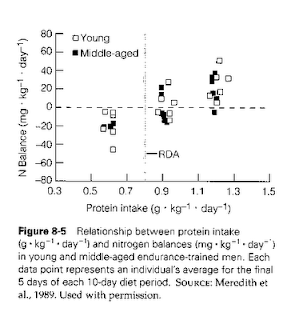How much protein does one need to be in nitrogen balance?

The figure below, from Brooks et al. (2005), shows a graph relating nitrogen balance and protein intake. A nitrogen balance of zero is a state in which body protein mass is stable; that is, it is neither increasing nor decreasing. The graph was taken from this classic study by Meredith et al. The participants in the study were endurance exercisers. As you can see, age is not much of a factor for nitrogen balance in this group. Nitrogen balance is greater than zero (i.e., an anabolic state) for the vast majority of the participants at 1.2 g of protein per kg of body weight per day. To convert lbs to kg, divide by 2.2. A person weighing 100 lbs (45 kg) would need 55 g/d of protein; a person weighing 155 lbs (70 kg) would need 84 g/d; someone weighing 200 lbs (91 kg) would need 109 g/d. The above numbers are overestimations of the amounts needed by people not doing endurance exercise, because endurance exercise tends to lead to muscle loss more than rest or moderate strength training. O

